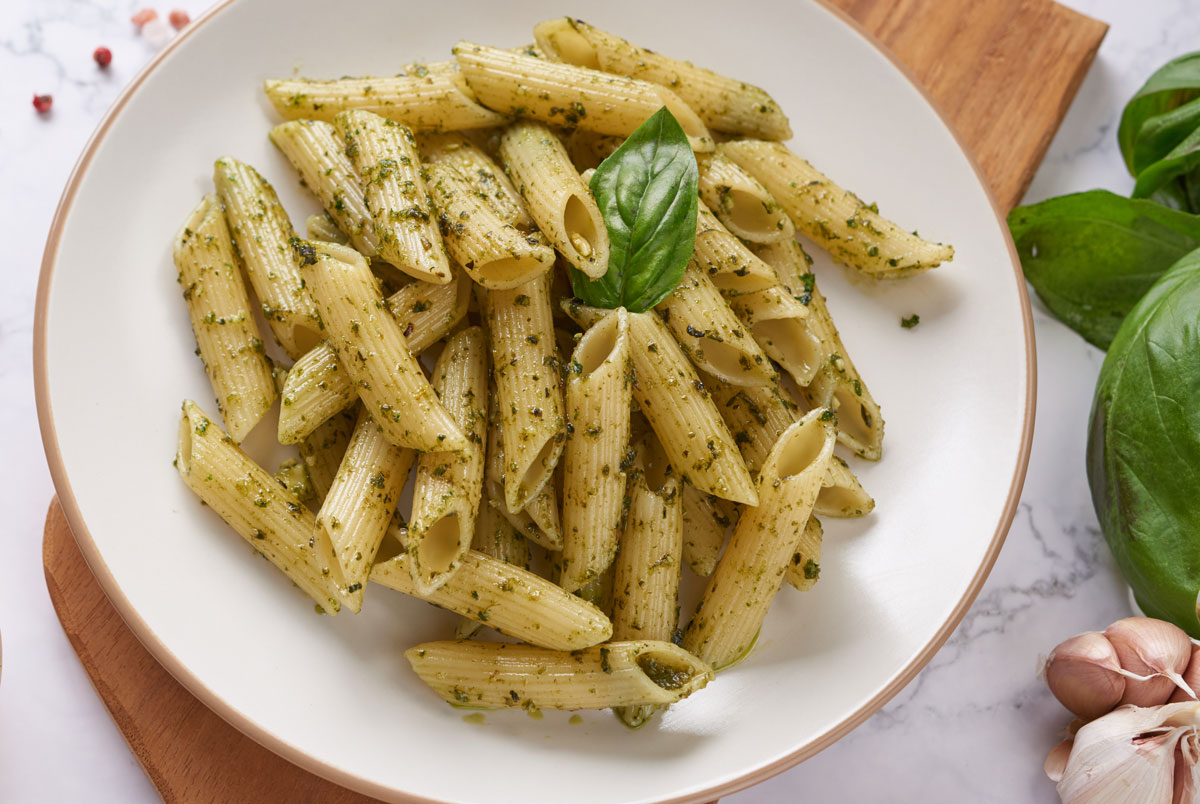Vegetarian Pesto Pasta Recipe: A Flavor-Packed Delight
Vegetarian pesto pasta is a dish that never goes out of style. Loved by vegetarians and pasta enthusiasts alike, it’s fresh, flavorful, and easy to make. Originating from Liguria, Italy, pesto itself is a timeless sauce with bold, herbaceous notes balanced by creamy richness. Paired with pasta, it’s a satisfying meal that feels indulgent yet wholesome, perfect for lunch, dinner, or even a quick recipe to impress guests. Let’s explore how you can create this culinary classic in your kitchen.
Ingredients for Vegetarian Pesto Pasta
To make the perfect vegetarian pesto pasta, you’ll need some fresh, quality ingredients. Here’s what you’ll need and why each ingredient is essential.

Fresh Basil
Fresh basil is the heart of any pesto recipe. Its aromatic and slightly sweet flavor creates the vibrant green base that gives this dish its signature taste. Always opt for fresh leaves, as dried basil won’t deliver the same boldness.
Pine Nuts
Pine nuts add a nutty, buttery texture that complements the basil. If you’re allergic to tree nuts, no worries—sunflower seeds or walnuts are great substitutes. Toasting the nuts enhances their flavor, so don’t skip that step.
Olive Oil
A high-quality extra-virgin olive oil is non-negotiable. It binds the ingredients into a creamy consistency while delivering richness. Look for oils labeled “cold-pressed” for the best flavor.
Parmesan Cheese (or Alternatives)
Traditional pesto calls for Parmesan, which provides salty and tangy notes. For vegetarians, ensure the cheese is rennet-free. If you’re lactose-intolerant, nutritional yeast or plant-based Parmesan alternatives work perfectly.
Pasta Choices
While long strands like spaghetti and linguine are classic, short pasta shapes such as penne, fusilli, or farfalle hold the sauce beautifully. Choose any pasta you love, or try whole-wheat or gluten-free options for a healthier twist.
Step-by-Step Cooking Instructions
Making vegetarian pesto pasta is as simple as blending, boiling, and combining. Here’s how to put it all together.
Preparing the Pesto
- Toast the pine nuts: Heat them in a dry skillet over medium heat until golden, about 2-3 minutes.
- Blend the ingredients: In a food processor, combine fresh basil, toasted pine nuts, grated Parmesan (or alternative), and a clove of garlic. Pulse until the mixture is slightly chunky.
- Add olive oil gradually: With the processor running, slowly pour in olive oil until the pesto reaches your desired consistency.
- Season to taste: Add salt and a squeeze of lemon juice for a bright finish.
Cooking the Pasta
- Boil water in a large pot. Add a pinch of salt for flavor.
- Cook the pasta according to the package instructions, ensuring it’s al dente. This means it should remain firm to the bite.
- Reserve ½ cup of pasta water before draining. The starchy water helps the pesto cling to the pasta.
- Toss the pasta with pesto. Add a splash of reserved pasta water if needed for extra creaminess.
Serving Suggestions
Plate your pasta with a garnish of freshly grated Parmesan, a drizzle of olive oil, and a sprinkle of cracked black pepper. Add a few whole basil leaves for a pop of color. Serve warm or enjoy it chilled as a pasta salad.
Variations of Vegetarian Pesto Pasta
Pesto pasta is endlessly versatile. Here are some ways to customize it to fit your preferences:
Adding Vegetables
Want more nutrition and texture? Toss in roasted cherry tomatoes, sautéed zucchini, or steamed broccoli. These veggies pair beautifully with pesto’s savory flavor.
Protein Additions
For extra protein, consider options like grilled tofu, chickpeas, or edamame. A handful of toasted pumpkin seeds also provide a delightful crunch.
Creamy Pesto Pasta
To create a richer dish, stir in heavy cream, cream cheese, or plant-based alternatives like cashew cream. This variation is perfect for those who love creamy sauces.
Nutritional Benefits of Vegetarian Pesto Pasta
Not only is this dish delicious, but it’s also packed with nutrients. Here’s why it’s a healthy choice:
Vitamins and Minerals
Basil is rich in vitamins A, C, and K, all of which support overall health. Pine nuts add magnesium and zinc, while Parmesan delivers calcium.
Healthy Fats
Olive oil provides monounsaturated fats, which help maintain heart health. Pine nuts also contribute omega-6 fatty acids, offering an energy boost.
Plant-Based Benefits
By sticking to vegetarian ingredients, you’re making a sustainable and cruelty-free meal choice. It’s a small step toward a more plant-based diet.
Vegetarian pesto pasta is a dish that’s fresh, flavorful, and easy to adapt. The beauty of this recipe lies in its simplicity and flexibility, making it suitable for anyone to enjoy. With its vibrant pesto sauce, al dente pasta, and endless variations, it’s bound to become a staple in your kitchen. So grab those ingredients, get blending, and treat yourself to a bowl of this Italian-inspired classic tonight.
